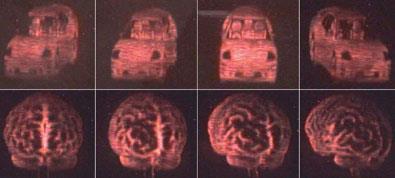Unique polymer used to make updatable holographic display
Watching televisions in 3D could be a reality in future thanks to a polymer that allows holograms to be recorded and erased on a single display.
Although static holograms are easy to produce, getting them to move has proved to be a lot more challenging. Now, for the first time, a team led by Nasser Peyghambarian at the University of Arizona has designed a 10cm-wide holographic display that can be erased and replaced with fresh images.

The secret, Peyghambarian told Chemistry World, is a novel polymer with unique ’photo-refractive’ properties. ’Our polymer has the ability to create holograms very quickly, the image persists for several hours, and then the image is gradually erased so it can be updated,’ he said.
Holograms are made by splitting a beam of laser light into two, then reflecting one off the object to be imaged. The two beams are then re-combined on a photosensitive material which stores the 3D signal in a complex pattern of interference. This pattern can be observed using an additional ’reading beam’ - when viewed from different angles, different parts of the object can be seen, giving the illusion of 3D.
The new polymer combines an aniline-based dye that responds to light with a tetraphenyldiaminobiphenyl group that enables electrons to move freely through the structure. Small amounts of a fluorinated chromophore and plasticizer were then added to encourage molecular motion and improve the brightness of the display.
Under an applied electric field, the laser ’writing beams’ are absorbed by the polymer, generating negative electrons and positive ’holes’. The holes move to the dark regions of the display, which alters the distribution of charge in the polymer structure. That causes the dye molecules to rotate and align differently with the electric field, changing the refractive index of the material.
The resulting hologram is observed using a reading laser, and this is also how the image is erased. The uniform illumination provided by the reading laser causes the particles to slowly return to their original state and the image fades away.
By increasing the voltage running through the polymer, the team were able to draw a full image in around 3 minutes and maintain it on the screen for 3 hours. But to make a 3D-video, the hologram would need to be refreshed many times a second.
’This research sets a new benchmark in re-recordable three dimensional holographic displays,’ Colin Davidson, an expert in hologram chemistry at Cambridge University told Chemistry World. ’There are many papers in this field already, but none have demonstrated photo-refractive polymers with a combination of both high diffraction efficiency and a capacity to quickly update the image.’
Lewis Brindley
References
S Tay et al, Nature, 2008, DOI: 10.1038/nature06596






No comments yet